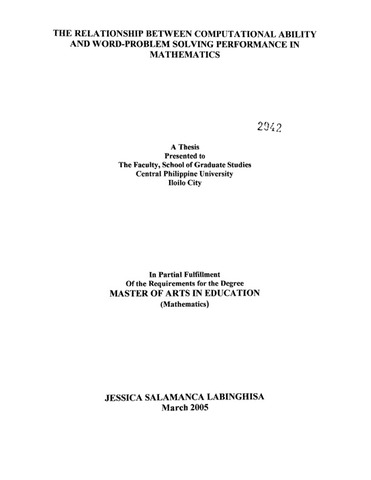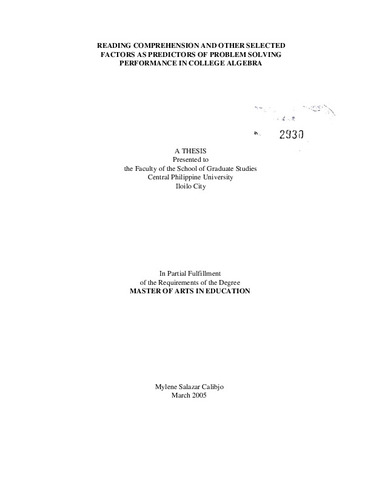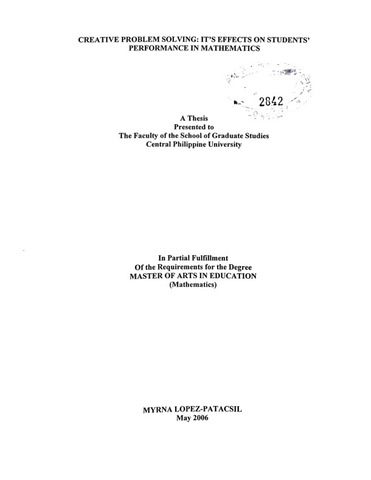| dc.description.abstract | This study determined the relationship between computational ability and word problem solving performance in mathematics of the 251 randomly selected senior high school students of Janiuay National Comprehensive High School, Janiuay, Iloilo, school year 2003-2004. Data were obtained through two sets of tests, one, on computational ability of 40 items and another, on problem solving performance of 10 items. The tests were content and face validated; pilot tested and reliability test was established using Cronbach Alpha.
Specifically, this study sought to find out the students' level of computational ability and problem solving performance in general and in their problem-solving sub-skills namely comprehension, equation formulation, solving equation and verification; if students’ level of computational ability and problem solving performance vary when grouped by sex and if computational ability is significantly correlated to problem solving performance. This study also determined the strengths and weaknesses of the students in computational ability based on 50 percent criterion.
In problem solving, strengths and weaknesses were determined by sub-skill, which involved problems on number relations, measurement, mixture, age and average problems. Abilities performed by at least 50 percent of the students were categorized as strengths and those performed below the 50 percent criterion were weaknesses of the students.
Statistics used were mean, percentages and standard deviation for descriptive analyses, t-test for significant differences between males and females and Pearson-r for significant relationship between computational ability and problem-solving performance.
Findings
The result of this study revealed that in general, the students' level of computational ability is above the 50 percent criterion. Computational ability for both males and females were above the 50 percent, though comparatively, the females performed significantly better than the males as shown by a significant difference in their mean scores and criterion levels.
The strengths of the students in computational ability were on topics evaluating algebraic sentences, number relations and linear equations, systems of linear equations and polynomials and their operations. On the other hand, their weaknesses were on rational expressions, quadratics and writing words and phrases as algebraic expressions. Less than 50 percent of the students performed well on these areas.
In problem solving, the students' levels of performance were below the 50 percent criterion; whether as an entire group or when grouped by sub-skill. When students were grouped by sex, levels of performance were better in comprehension. Female students performed significantly better than male students in all sub-skills. Problem solving as a whole was a weakness to most students. Results revealed that computational ability is significantly correlated to problem-solving performance with r= .71. The higher the computational ability, the higher is the problem solving performance.
Conclusion
In the light of these findings, it is inferred that the students’ level of computational ability was slightly above the 50 percent criterion level. Both the male and female students performed above the 50 percent criterion. The female students performed significantly better than their male counterparts in computational ability.
The students have strong computational ability in the areas of systems of linear equations, polynomials and their operations and evaluating sentences, number relations and linear equations, but they are weak on the areas of rational expressions, quadratics and writing words and phrases as algebraic expressions on questions with higher complexity of skills.
The students’ level of performance in problem solving was below 50 percent criterion as a whole and by sub-skill. When grouped by sex, the level of performance was better in comprehension than for other sub-skills. Problem solving performance between males and females vary with female students better off than their male classmates.
The number of students getting correct responses decreases by sub-skill for errors or incomplete answers on the previous greatly affected answers on the next except on verification where it was performed slightly higher than solving equation since students verified their answers using other methods other than making and solving equations which implies that students have difficulty in solving problems using equations.
Computational ability is strength among students while problem solving is their weakness. Computational ability is significantly correlated to problem solving, r= .71. The higher the computational ability, the higher is the problem-solving performance. It is not surprising to know that students got low in problem-solving which entails higher cognitive ability for they only attained slightly above the 50 percent criterion on computational ability which was the lowest level of cognition. Students failed to attain the higher thinking skills as shown by their performance in problem solving, which was below the 50 percent criterion.
Findings imply that students will graduate in high school with inadequate abilities needed of them to face the next level of higher education. At their age level, as described by Piaget (1971), they are supposed to be at the abstraction level, however, as seen in their scores, they failed to attain the level. Students failed to exhibit analytical thinking. Though the tests were similar to the exercises found in their textbooks, yet, they got low in their performance in mathematics, which affirmed the findings of Penuela (1996; Palmares, 1998; Calizo, 2000) that students are poor on problem solving. This is also affirmed by Bagaforo (1999) in her study on competencies of prospective teachers where she found them poor in problem solving.
Recommendations
1. It is highly recommended that Mathematics be taught seriously at its early stage, starting from elementary grades where children took the basics.
2. Since students only obtained mediocre results in their tests in computational ability, concepts and skills should therefore be strengthened since these are the basic abilities and skills needed to a successful problem solving.
3. In the teaching of Mathematics, especially problem solving, the male students should be given attention for they performed much lower than the female students. Often they should be asked to participate in classroom activities.
4. The beginning of Mathematics abstraction is symbols; hence the language of symbols should be prioritized and taught with various levels of difficulty. More drills should be given to mathematical translations; equation formulation and solving equation for these are essential to problem solving.
5. Since topics in finding the least common denominator, simplifying, finding the roots of rational expressions and quadratics are weaknesses of the students, these topics should be given more examples. Presentations should be logical starting from whole numbers to fractions, then to algebraic expressions. Teachers should also emphasize among students that in finding the roots of perfect numbers, no radical signs are placed on the answers.
6. More attention should be given to problems on rational expressions and quadratics for these were the topics students’ were found very weak. They should be given series of realistic examples, assignments and activities to be performed. They should be drilled on how mathematics problems should be presented and described in worded form or vice versa. Students should create their own problems based on their daily life activities for them to realize applications of mathematics in their actual living. They should provide solutions and strategies to problems they made so that they will develop mastery of mathematical skills, critical and analytical as well.
7. Verification should not be taken for granted for this skill make students reflect on the correctness of their answers.
8. Research on strategies and techniques of teaching students of diverse mental abilities and educational background should be encouraged. | en_US |





